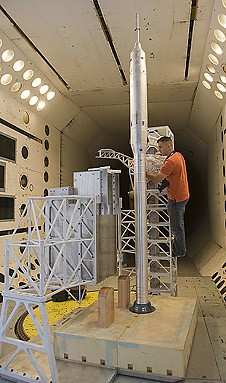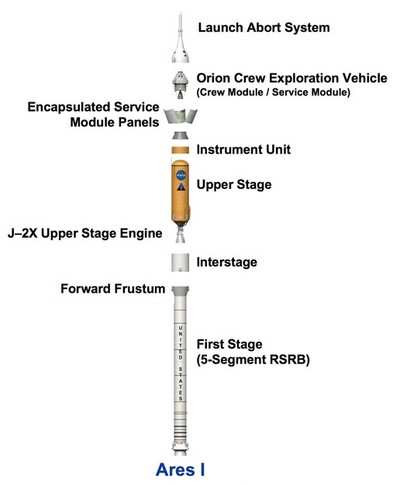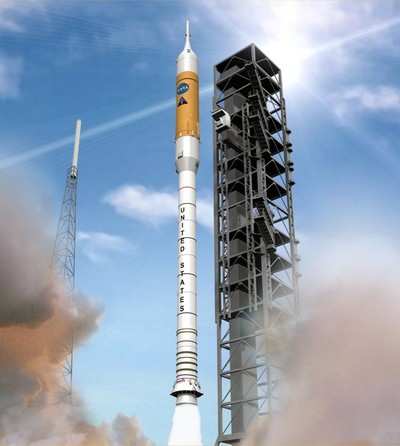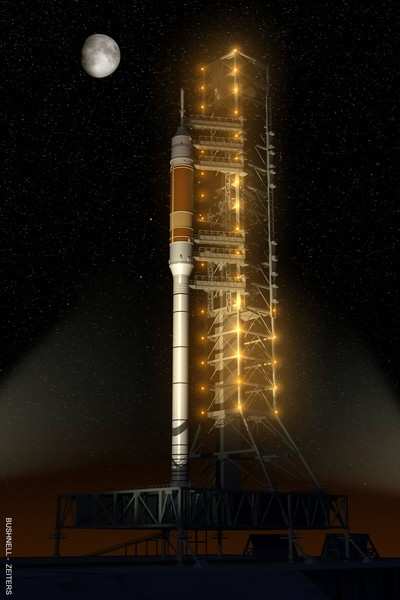NASA Provides A Close-Up Look At Transonic Testing
 In front of the console, his right hand on a dial, John Meador
sang out, "I'm at 85."
In front of the console, his right hand on a dial, John Meador
sang out, "I'm at 85."
"Taking data," Dean Heald responded from behind his laptop
computer.
Between them, Tom Ivanco looked up at a screen, where
red-lighted letters indicated instrument readings. In front of the
three was a wall of small windows, though which you could see a
shiny, aluminum model of Ares I-X shimmy ever so slightly.
The whoosh! of R-134a gas blowing on the 13-foot, 350-pound
(3.96 m, 158.8 kg) model in the tunnel indicated business for NASA
Langley Research Center's Transonic Dynamics tunnel. But hardly
business as usual.
"I used to wish I had been here in the heydays of the Apollo
era," said Ivanco, who wasn't born when Neil Armstrong walked on
the moon. "I used to think that must have been something, working
for NASA back then, going to the moon, pioneering. Now that we're
going back, it's kind of neat to see. We kind of get a taste of
what it might have been like."
As it was during Apollo days, the TDT is being used to test
ground wind loads on Ares I-X for the program's Systems Engineering
and Integration office.
"The wind tunnel work is critical to the overall stabilization
assessment," said Kurt Detweiler, Ares I-X lead systems
engineer.
Ares I-X is the first test flight in the development of the Ares
I rocket, part of NASA's Constellation program that, beginning in
2015, will launch the Orion crew exploration vehicle to the
International Space Station. The rocket also will be used for
missions to explore the moon and beyond.
Four decades ago, the TDT was used to test the Saturn V rockets
that sent Apollo aloft. Today's testers have been in contact with
those of Apollo to learn how they did it.
But if today's tests are in many ways like those of Apollo,
they're also different because the rockets are so different. At 325
feet (99 m) from tip to stern, but with a first stage only 13 feet
(3.96 m) in diameter, getting Ares I-X out to a launch pad and
leaving it there has been likened to "balancing a pencil."
If a 33-story brick and mortar building can wave in the wind, an
aluminum rocket certainly can. Design analysts say it can stay
upright in a 47-knot wind while moving at 0.9 mph (1.45 kph) on a
crawler from a hangar to the launch pad while fastened in four
places at the rocket's base.
They also say that with bracing -- called "damping" -- it can
withstand a 65-knot wind on the launch pad. With as many as 30 days
on the pad prior to launch, Ares I-X could face a wide variety of
weather conditions.

But how much wind can it take without damping, which would not
be available at launch? Wind on the launch pad can make Ares I-X
sway as much as eight feet at its tip, but workers can't be on the
platforms to service the rocket if it's swaying more than three
inches (7.62 cm). Much more than that and the access platforms have
to be withdrawn to keep the rocket from bumping into them.
"We're helping to define what the constraints are and what the
viable launch conditions are," said Russ Rausch, team lead for the
testing.
Also, too much oscillation could stress the metal where the
rocket is bolted to the launch pad.
Meador, Heald and Ivanco and others are checking all of those
numbers the old-fashioned way, by testing them in a wind tunnel.
The tests also are generating numbers for future rocket
development.
"People will use this data for not only analyzing this vehicle,
but also for developing computer programs to try to predict this,"
said Don Keller, who oversees the testing and preparation of the
Ares I-X model. "This is very difficult to predict computationally,
even though it seems very simple in testing. Flow over a cylinder
at slow speed is a very complicated phenomenon because, as the flow
goes over the vehicle, it separates. Its very hard to model."
That separation generates vortices on the side of the rocket
away from the wind, and those vortices can make Ares I-X oscillate
in any number of directions.

To do the test, the model is mounted on a 40-year-old, six-ton
(5.44 metric ton) turntable. The model is fitted with 18
accelerometers and 16 transducers to provide readings when the gas
is blown onto it in the tunnel, simulating wind.
Everything is scaled, so the force of the gas is translated into
that of wind on Launch Pad 39B at Kennedy Space Center. That the
gas is 3-1/2 times as dense as wind is another factor, as is the
size and mass of the model.
"We're starting at 50 feet per second (34.1 mph, 54.9 kph) here
and going up to 200 feet per second (136.4 mph, 219.5 kph)," said
Keller of the velocity of the gas. "We had a high response when we
were blowing the tunnel at about 85 feet per second (57.9 mph, 93.3
kph), which is about 30-35 knots on the pad."
After the test at 50 feet per second (34.1 mph, 54.9 kph),
Meador's right hand moves the dial clockwise ever so slightly,
gradually increasing the flow of gas to 55 feet per second (37.5
mph, 60.4 kph).
"Taking data," sings out Heald. He does so every five feet per
second of gas to 200. Then the turntable rotates the model five
degrees, and they begin again.
It's time consuming and tedious: 31 wind readings, each about 15
seconds long, 500 samples per second. And all taken from 72 angles
around the rocket model.

"It takes about 30 minutes per wind angle to get our data,"
Keller said.
Then a model launch tower is added to the turntable, and the
whole thing begins anew, because the tower will have an effect on
the wind that reaches Ares I-X. How much effect on wind and from
which direction are why they are testing.
Each step in the test is important in determining which way the
rocket will sway in what wind direction and speed. In certain
conditions, Ares is likely to not only sway at its tip, but bow in
its middle: a phenomenon called "second mode."
Add even the tiniest protuberance on the rocket to take the
cylinder out of round and yet another variable is introduced.
Ultimately, the process is designed to determine boundaries of
safety. "We're trying to be conservative when we do this," Keller
said. "You want to bracket the problem."
That they are doing some of the same things in the same place
that NASA did when it went into the space exploration business four
decades ago is not lost on any of the people at the Transonic
Dynamics Tunnel.

"In the '60s, this tunnel had a huge role in space," Keller
said. "It seems to me like a once-in-a-generation opportunity."
(ANN thanks Jim Hodges and Keith Henry, NASA Langley
Research Center. Top photo by Sean Smith)
 ANN's Daily Aero-Term (04.14.24): Maximum Authorized Altitude
ANN's Daily Aero-Term (04.14.24): Maximum Authorized Altitude ANN's Daily Aero-Linx (04.14.24)
ANN's Daily Aero-Linx (04.14.24) Classic Aero-TV: 'We're Surviving'-- Kyle Franklin Describes Airshow Life 2013
Classic Aero-TV: 'We're Surviving'-- Kyle Franklin Describes Airshow Life 2013 Aero-News: Quote of the Day (04.14.24)
Aero-News: Quote of the Day (04.14.24) Airborne 04.09.24: SnF24!, Piper-DeltaHawk!, Fisher Update, Junkers
Airborne 04.09.24: SnF24!, Piper-DeltaHawk!, Fisher Update, Junkers







